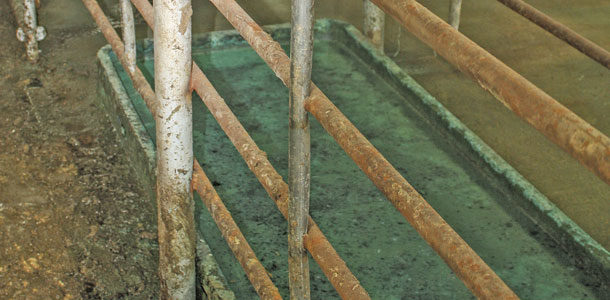Understanding the purpose of a footbath and how to more effectively use one on your dairy can save money and enhance the safety of cows, people and the environment. With all the talk and various topics concerning footbaths, the truth is that here has been very little true research on the topic. Most information is what seems to work at various places.
I have been involved in the dairy industry most of my life: growing up as a farm kid, spending more than 10 years in dairy supply sales and nearly 20 years as a hoof trimmer. Through these experiences, I have observed both good and poor footbath management. The following are a few questions you may have, along with my answers based on what I see on dairies.
- Do footbaths work? The answer is yes, footbaths work – and no, they do not. Some major issues in using footbaths are need, correct use, how to limit use and alternatives.
- Are footbaths needed? Not always. I trim for many herds with no need for a footbath. These dairies have little to no foot issues other than long toes. Some farms may additionally have just a few cases of hairy warts. On these dairies, the producer or a hoof trimmer can effectively treat these cases as they arise.
- Why are they used? Determining the problem one is trying to correct is the beginning step. Footbaths, if used correctly, can help control hairy warts and foot rot. If ulcers are a main hoof concern, a footbath is of little help.
- How frequently should you use a footbath? Upon talking with other trimmers, we agree that one case of hairy warts per 20 cows is a breaking point. Obviously, if little to no hairy warts or hoof rot is occurring, then footbath use is not needed. Increase use when problems develop.
-
Are they used correctly? A common mistake I see is baths that are too short, which then limits the number of “dunks” the cow makes with her feet as she passes through the bath. The desired length is 10 to 12 feet.
At this length, cows typically can get two dunks per foot. Several years ago, some people advocated a pre-bath to clean feet. Most everyone agrees this only saturates the hoof and surrounding tissue, thus preventing the desired penetration of footbath solution.
Newer protocols are recommending narrower baths. Additionally, putting up splash guards on the sides of the bath help to contain the solution, prevent cows from sidestepping and keep cow traffic moving through more quickly.
Proper solution strength is important. If the solution is dirty or not the correct concentration, then the footbath is of little help. I consistently see farms with poorly maintained baths full of manure. Likewise, stronger is not always better; it is more costly and in some cases, skin burning and irritation occurs.
Care and follow-through are important when preparing the footbath. Too often, the farm manager establishes the correct formulation and protocols, but the person actually preparing the footbath doesn’t catch all of the details.
There are also motivational concerns that may influence how often the solution is changed. For example, the bath may be in need of changing at the end of the last group of cows passing through; unfortunately, these are often the slower cows – the ones that may need the footbath the most.
- What about chemicals? The continued use and overuse of chemicals and solutions in footbaths is a serious concern. Their use can also be very expensive and not effective if used wrong. Be sure to use the concentration at the recommended strength and avoid higher concentrations to eliminate irritation and overuse.
Most of the chemicals used for footbaths are not safe for cows, people or the environment. One of the most popular and effective chemicals used in footbaths is formaldehyde, a known carcinogen.
Use with caution, as high concentrations can cause tissue damage in both cows and humans, and its vapor is not safe to breathe. Furthermore it does not work when the temperature is below 40ºF. One needs to consider proper storage, ventilation and handling. With its many issues, use formaldehyde sparingly.
Copper sulfate is another popular and effective product. Its use as an antimicrobial dates back hundreds of years. Copper sulfate is the key ingredient in Bordeaux mixture, which is spayed on grape fields to limit fungal growth.
As a solution in a footbath, it helps control both foot rot and hairy warts (digital dermatitis). A major drawback to its use is that high levels in soil can lead to disruption in plant growth. It is also expensive. Several products are available to add to copper sulfate which can amplify its effect.
Some of these products have an acidifying or a surfactant (wetting) agent. These products may limit some of the environmental concerns of the copper sulfate. Additional handling is a drawback, and results may not offset added costs.
Be careful if choosing other products for footbaths. In many cases, some new products have initial success not because the chemical worked better, but because the setup was better, cows walked through better or other factors changed.
I am a hoof trimmer. I am not a chemical salesperson. I do not want to promote or sell a product. My goal is to enhance hoof health for the cows and producers I work with. I ultimately want to make my customers more profitable.
Here are some tips I tell my clients fror more effective footbath usage:
- Scrape or clean more often. Many dairies scrape or clean alleys once a day. The amount of effort it takes to scrape is about the same it takes to set up a footbath. Even if footbaths are used, they will be more effective if cows walk in a cleaner environment.
- Spray individual lame cows in the parlor.
- Cutting back footbath use to only a few times per week can save a lot of money.
- Correctly mix the footbath to proper concentration strength. Have the same person preparing for consistency.
- Trim more often
. - In extreme cold, use a dry bath (copper sulfate mixed with lime).
- Be cautious of the “new potion” from a chemical salesperson that went to a one-week school and claims to be an expert.
Using footbaths more effectively can save money and enhance the safety of cows, people and the environment. PD
PHOTO
A well-managed footbath can be an effective way to control digital dermatitis and foot rot. Photo by Peggy Coffeen.

Edwin ‘Skip’ Blake
Shamrock Cow Care







